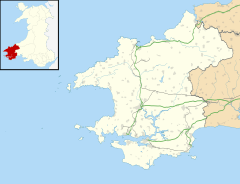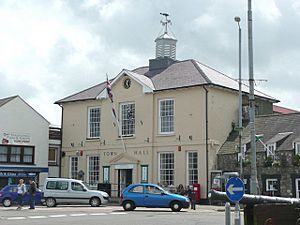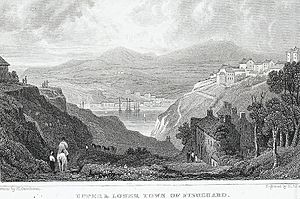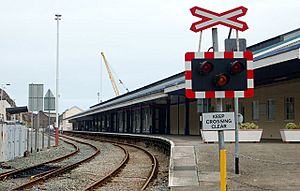Fishguard facts for kids
Quick facts for kids Fishguard
|
|
|---|---|
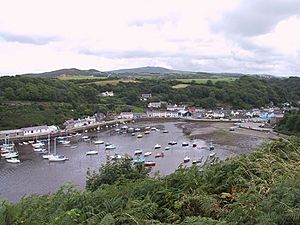 Lower Fishguard |
|
| Population | 5,407 |
| OS grid reference | SM955375 |
| Community |
|
| Principal area | |
| Ceremonial county | |
| Country | Wales |
| Sovereign state | United Kingdom |
| Post town | FISHGUARD |
| Postcode district | SA65 |
| Dialling code | 01348 |
| Police | Dyfed-Powys |
| Fire | Mid and West Wales |
| Ambulance | Welsh |
| EU Parliament | Wales |
| UK Parliament |
|
| Welsh Assembly |
|
Fishguard (called Abergwaun in Welsh, which means "Mouth of the River Gwaun") is a town on the coast of Pembrokeshire, Wales. In 2011, about 3,419 people lived there. The larger area of Fishguard and Goodwick had a population of 5,407.
Fishguard is made of two main parts:
- Lower Fishguard: This is thought to be where the town first started. It's a typical fishing village located in a deep valley where the River Gwaun meets the sea. You can still see a small quay there.
- Main Town: This part is on a hill above Lower Fishguard. It has the main church, the High Street, and most of the newer buildings. It's connected to Lower Fishguard by a steep, winding road. The part of town facing Goodwick grew a lot in the early 1900s when Fishguard Harbour was developed.
Fishguard and Goodwick are often called "twin towns" because they share a Town Council.
Contents
What's in a Name?
The English name Fishguard comes from an old Norse word, Fiskigarðr. This means "fish catching enclosure." It's similar to the modern English words fish and yard.
The Welsh name, Abergwaun, means "the mouth of the River Gwaun." The river's name describes the high, wet, flat ground of a marsh or moor.
A Look Back in Time
Fishguard is in an old Welsh area called Cemais. It was also part of the historic Welsh kingdom of Dyfed. During the Viking Age, Norse (Viking) raiders often visited the coasts of Wales. Between 950 and 1000 AD, Norse trading posts and settlements appeared in Dyfed, and Fishguard was one of them.
The English name suggests there might have been a Scandinavian trading post here. You can still see old V-shaped stone structures at low tide on both sides of the bay. These were ancient fish traps, likely used to catch fish as the tide went out. Similar traps have been used since ancient times.
Fishguard was called Fiscard until the early 1800s when its name became more English. It was an important town with a special leader called a portreeve. The original Norman settlement was along what is now High Street.
In 1912, a pilot named Denys Corbett Wilson made the first flight between Britain and Ireland. He started his journey in England and landed in Goodwick on April 21st. The next day, he took off from a field near Harbour Village and landed in Ireland about 100 minutes later.
Lower Fishguard became a busy port for catching and trading herring. It traded with Ireland, Bristol, and Liverpool. In the late 1700s, it had many ships and exported oats and salted herring.
- The Last Invasion: In 1779, a privateer ship called the Black Prince attacked the port. The town refused to pay a ransom, so the ship fired cannons at it. Because of this, Fishguard Fort was built in 1781 to protect Lower Fishguard. The port became less busy in the late 1800s.
Fishguard is famous for the "last invasion of mainland Britain." This happened on February 22–24, 1797. About 1,400 French soldiers landed near Fishguard. However, they surrendered just two days later. The story says that Welsh women in traditional costumes helped scare the invaders.
The surrender was signed at Fishguard's old Royal Oak public house. To remember this event, a special tapestry was made in 1997. It's like the famous Bayeux Tapestry and is on display in the Town Hall Library.
During the Second World War, the Fishguard Bay Hotel was used by a secret group called Special Operations Executive. They tested special underwater vehicles in Fishguard Bay.
Where is Fishguard?
Fishguard is located at the back of Fishguard Bay. This bay protects the town from strong waves. The weather here is usually mild because it's by the coast. Winds from the west or south-west affect the temperature and rainfall.
In Fishguard Bay, there's a small island called Needle Rock, which is 131 feet (40 meters) tall.
- Wildlife: The area around Fishguard has lots of different wild flowers and sea animals. You might see grey seals, porpoises, and dolphins. Many birds live here too, like Eurasian curlews and common redshanks. You can often spot them looking for food in Lower Fishguard Harbour.
Who Lives in Fishguard?
In 2001, Fishguard had 3,193 people living in 1,465 homes. About 39.8% of the people could speak Welsh. This number was higher in the past, with 58.9% speaking Welsh in 1951 and 90.3% in 1901.
Here's a breakdown of the population by age in 2001:
| Age Distribution | Fishguard | Pembrokeshire |
| 0–4 years | 5.8% | 5.8% |
| 5–15 years | 13.0% | 14.6% |
| 16–19 years | 3.7% | 4.8% |
| 20–44 years | 24.4% | 28.4% |
| 45–64 years | 25.2% | 27.2% |
| 65+ years | 27.9% | 19.2% |
Important Places to See
Outside Fishguard, there's a stone monument that remembers the signing of the peace treaty after the last invasion of Britain in 1797. It's said that Welsh women in traditional costumes helped surprise the invaders.
The 19th-century church of St Mary's has a special stone for Jemima Nicholas. She was a local hero who helped fight off the French invasion. There's also another memorial stone in West Street, Fishguard, to mark the 200th anniversary of the invasion. The Fishguard Tapestry, which tells the story of the invasion, is on display in the Town Hall Library.
Fishguard has more than 80 listed buildings, which are buildings with special historical or architectural importance.
Community Life and Fun
Fishguard has many hotels and is the main shopping town in North Pembrokeshire. You can find a market in the town hall on Tuesdays, Thursdays, and Saturdays.
The Fishguard Round Table is a group that does community work. They help organize the Fishguard & Goodwick Carnival and the Fishguard Autumn Festival.
The Gwaun Lodge of the Royal Antediluvian Order of Buffaloes is another group that helps the community. They host events and do charity work all year.
Fishguard has a cinema and theatre called Theatr Gwaun with 180 seats. It shows films, music, and live plays. This theatre also hosted the National Eisteddfod (a big Welsh festival) in 1936 and 1986. Theatr Gwaun also puts on an annual pantomime, performed by local community members.
Getting Around
Fishguard is at the end of the A40 road, which is a main road from London.
A ferry run by Stena Line regularly travels between Fishguard Harbour in Goodwick and Rosslare in Ireland.
You can also travel by train from Fishguard Harbour railway station and Fishguard and Goodwick railway station. These trains, run by Transport for Wales Rail, go to Swansea and Cardiff.
Fishguard in Movies
Lower Fishguard was used as the setting for "Llareggub" in the film Under Milk Wood. This movie starred famous actors like Richard Burton, Elizabeth Taylor, and Peter O'Toole. Many local people were extras in the film.
The movie Moby Dick, starring Gregory Peck, was also filmed there in 1955.
Local Businesses
The Fishguard and Goodwick Chamber of Trade and Tourism is a group that supports local businesses and tourism.
Twin Town
Fishguard is twinned with a town in France called Loctudy, in Brittany.
Images for kids
See also
 In Spanish: Fishguard para niños
In Spanish: Fishguard para niños


